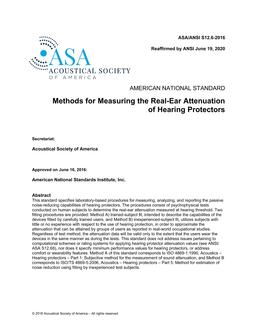
Click here to purchase
This standard specifies laboratory-based procedures for measuring, analyzing, and reporting thepassive noise-reducing capabilities of hearing protectors. The procedures consist of psychophysicaltests conducted on human subjects to determine the real-ear attenuation measured at hearing threshold.Two fitting procedures are provided: Method A) trained-subject fit, intended to describe the capabilitiesof the devices fitted by carefully trained users, and Method B) inexperienced-subject fit, utilizes subjectswith little or no experience with respect to the use of hearing protection, in order to approximate theattenuation that can be attained by groups of users as reported in real-world occupational studies.Regardless of test method, the attenuation data will be valid only to the extent that the users wear thedevices in the same manner as during the tests. This standard does not address issues pertaining tocomputational schemes or rating systems for applying hearing protector attenuation values (seeANSI/ASA S12.68), nor does it specify minimum performance values for hearing protectors, or addresscomfort or wearability features. Method A of this standard corresponds to ISO 4869-1:1990, Acoustics —Hearing protectors — Part 1: Subjective method for the measurement of sound attenuation, and MethodB corresponds to ISO/TS 4869-5:2006, Acoustics—Hearing protectors — Part 5: Method for estimationof noise reduction using fitting by inexperienced test subjects.
Product Details
- Published:
- 06/16/2016
- ANSI:
- ANSI Approved
- Number of Pages:
- 50
- File Size:
- 1 file , 1 MB